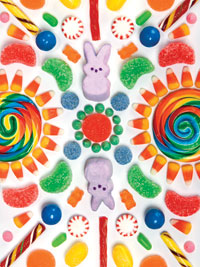Bittersweet Reflections on Our Favorite Drug
By Matt Windsor

Our romance with sugar, historically speaking, has been brief. Honey has been a staple of the human diet since the beginning of recorded history—both Aristotle and Virgil waxed philosophical on the subject of the honeybee. But the art of turning cane and beets into pure sucrose, or table sugar, remained a secret of Polynesia and India until Arab traders took it as far as Spain in the seventh century A.D. Northern Europeans didn’t get their first taste until several hundred years later, when returning Crusaders brought back word of an unforgettable new spice.
As long as sugar had to be imported from the East, it was a luxury. The price in London in 1319 was around $100 for a little more than two pounds of the miracle sweetener. After massive sugarcane plantations sprung up in the colonized New World, however, prices fell and consumption has risen steadily ever since.
According to a recent article in the New Yorker, the annual consumption of sugar in England reached four pounds per person in 1700, 18 pounds in 1800, and 90 pounds by 1900. In 2006, Americans ate their way through a little less than 139 pounds of cane sugar, corn syrup, and other natural sugars per person.
Article SectionsDiet Disaster? |
The only thing keeping us from eating our weight in sweets every year, it seems, is the fact that the centuries-long sugar surge has been matched by an equally sharp rise in average body weight. This is no coincidence. Sucrose and modern improvements such as high-fructose corn syrup are implicated in many of our most pressing health concerns, including obesity, diabetes, and even Alzheimer’s disease and cancer.
Part of the problem, of course, is that sugar is one of life’s greatest pleasures. Biologically, chemically, and psychologically, it is hard to give up and almost impossible to avoid. As an ingredient in everything from baby formula to Geritol, sugar stalks us from the cradle to the grave. But this ubiquitous, seductive powder still has its secrets. From the cane fields of Brazil to a local kitchen, from the boundaries of cancer research to the inner recesses of our minds, sugar has many stories to tell.